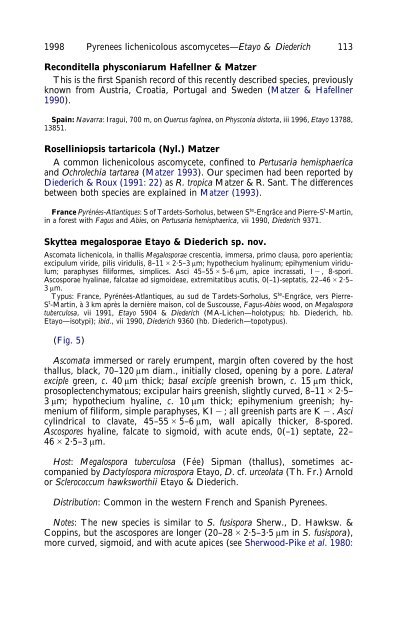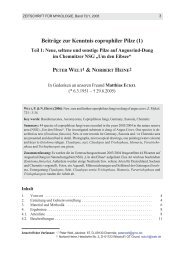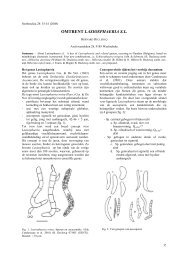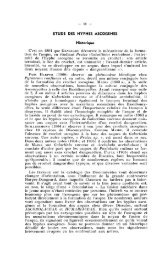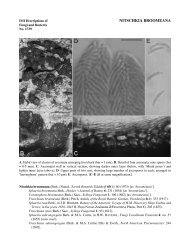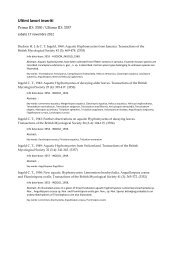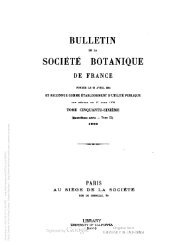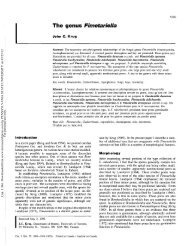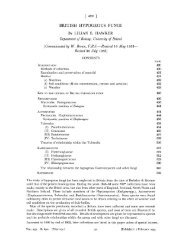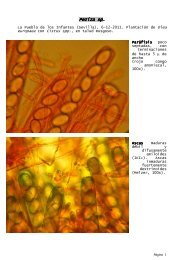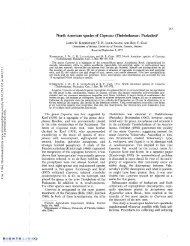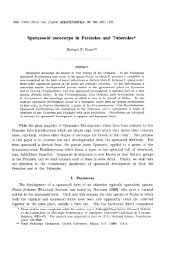LICHENICOLOUS FUNGI FROM THE WESTERN PYRENEES, FRANCE AND SPAIN ...
LICHENICOLOUS FUNGI FROM THE WESTERN PYRENEES, FRANCE AND SPAIN ...
LICHENICOLOUS FUNGI FROM THE WESTERN PYRENEES, FRANCE AND SPAIN ...
Create successful ePaper yourself
Turn your PDF publications into a flip-book with our unique Google optimized e-Paper software.
1998 Pyrenees lichenicolous ascomycetes—Etayo & Diederich 113<br />
Reconditella physconiarum Hafellner & Matzer<br />
This is the first Spanish record of this recently described species, previously<br />
known from Austria, Croatia, Portugal and Sweden (Matzer & Hafellner<br />
1990).<br />
Spain: Navarra: Iragui, 700 m, on Quercus faginea,onPhysconia distorta, iii 1996, Etayo 13788,<br />
13851.<br />
Roselliniopsis tartaricola (Nyl.) Matzer<br />
A common lichenicolous ascomycete, confined to Pertusaria hemisphaerica<br />
and Ochrolechia tartarea (Matzer 1993). Our specimen had been reported by<br />
Diederich & Roux (1991: 22) as R. tropica Matzer & R. Sant. The differences<br />
between both species are explained in Matzer (1993).<br />
France Pyrénées-Atlantiques: S of Tardets-Sorholus, between S te -Engrâce and Pierre-S t -Martin,<br />
in a forest with Fagus and Abies, onPertusaria hemisphaerica, vii 1990, Diederich 9371.<br />
Skyttea megalosporae Etayo & Diederich sp. nov.<br />
Ascomata lichenicola, in thallis Megalosporae crescentia, immersa, primo clausa, poro aperientia;<br />
excipulum viride, pilis viridulis, 8–112·5–3 m; hypothecium hyalinum; epihymenium viridulum;<br />
paraphyses filiformes, simplices. Asci 45–555–6 m, apice incrassati, I, 8-spori.<br />
Ascosporae hyalinae, falcatae ad sigmoideae, extremitatibus acutis, 0(–1)-septatis, 22–462·5–<br />
3 m.<br />
Typus: France, Pyrénées-Atlantiques, au sud de Tardets-Sorholus, S te -Engrâce, vers Pierre-<br />
S t -Martin, à 3 km après la dernière maison, col de Suscousse, Fagus-Abies wood, on Megalospora<br />
tuberculosa, vii 1991, Etayo 5904 & Diederich (MA-Lichen—holotypus; hb. Diederich, hb.<br />
Etayo—isotypi); ibid., vii 1990, Diederich 9360 (hb. Diederich—topotypus).<br />
(Fig. 5)<br />
Ascomata immersed or rarely erumpent, margin often covered by the host<br />
thallus, black, 70–120 m diam., initially closed, opening by a pore. Lateral<br />
exciple green, c. 40m thick; basal exciple greenish brown, c. 15m thick,<br />
prosoplectenchymatous; excipular hairs greenish, slightly curved, 8–112·5–<br />
3 m; hypothecium hyaline, c. 10m thick; epihymenium greenish; hymenium<br />
of filiform, simple paraphyses, KI; all greenish parts are K. Asci<br />
cylindrical to clavate, 45–555–6 m, wall apically thicker, 8-spored.<br />
Ascospores hyaline, falcate to sigmoid, with acute ends, 0(–1) septate, 22–<br />
462·5–3 m.<br />
Host: Megalospora tuberculosa (Fée) Sipman (thallus), sometimes accompanied<br />
by Dactylospora microspora Etayo, D. cf. urceolata (Th. Fr.) Arnold<br />
or Sclerococcum hawksworthii Etayo & Diederich.<br />
Distribution: Common in the western French and Spanish Pyrenees.<br />
Notes: The new species is similar to S. fusispora Sherw., D. Hawksw. &<br />
Coppins, but the ascospores are longer (20–282·5–3·5 m inS. fusispora),<br />
more curved, sigmoid, and with acute apices (see Sherwood-Pike et al. 1980:


